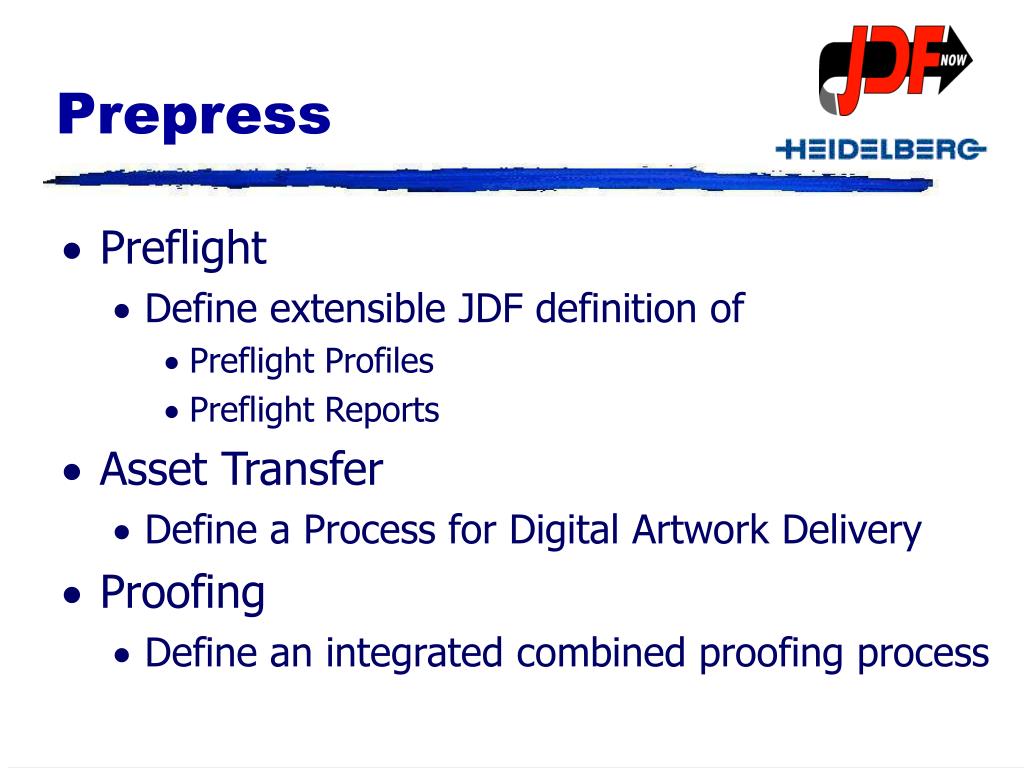

Instead we often get garbage jpegs with low resolution photos. We have an extensive library of templates and pages of file setup information on our site that often never gets used.

No matter what tools a printer gives a customer to help them create a high quality file, they often fail to use them. You absolutely have to preflight to normalize the files in the most efficient and reliable way you can. If you don't preflight then you cannot quality check your raw materials (PDF's) to ensure a stable production process. You need as predictable and reliable file as you can get. Which means you need to control everything about your workflow. Which means you have to control your processes. It's more cost effective to have one of those tools to save time on labor spending dinking around.įor you as a "commodity printer" (printing is a commodity any more) it is especially important? Why? Because you need to control your costs.
#DESIGN PREFLIGHT DEFINITION PDF#
It's hard to get by in a PDF based workflow without PitStop or callas for preflighting and fixing PDF's. In some respects callas pdfToolbox may be a better fit for your color needs. I'd need a lot more information about what you're thinking. Otherwise it's PhotoShop.Īdjusting ink densities with PitStop is not necessarily an easy thing to do. You might be able to do some of your edits with callas pdfToolbox depending on what it is that needs to be done. If you're talking about a raster image saved as PDF then there is only a few things that you can do to a PDF with PitStop. It all depends though, they may not be what you need to edit. Often there is still some vector objects around to edit. If the transparency is flattened then not all hope is lost. Do you mean the transparency has been flattened? Are you referring to a raster image saved as a PDF? We plan to hit the ground running so any suggestions are greatly appreciated.įirst we need to figure out what you mean by a "flattened file". Based on what I typed above about the style of shop we are, would any of you suggest the need for Pitstop? The only reason why I see we might need it is to adjust ink densities. It comes with a Harlequin Scriptworks RIP that can handle PostScript or PDF ver. Our shop will be receiving a used Ryobi 3404 DI in about a month. They are flattened, multi-upped by using actions we've created, and then sent to a Creo RIP or to an outside company. We currently check files for these requirements in Photoshop CS4. As long as the files are 300 dpi, CMYK color mode, and have adequate bleed/cut margin, they get printed. They are not super discriminate when it comes to color. The company's base of customers primarily need fast turnaround printing. Almost 1,750,000 clicks and going strong! Two of the last 8 years we've been running a Xerox 700 into the ground. For the last 8 years it has brokered out all of its offset work. No greater burden: Surviving an aircraft accident - YouTube (external link) Air Safety Institute: Avoiding power-on stallsĭiscusses the difference between stalling in practice and stalling in reality.The company that I work for is considered a "commodity" style printer. Weather Wise: Beyond Go/No-Go - YouTube (external link) Air Safety Institute – No greater burden: Surviving an aircraft accidentĪn accident case that speaks about IMSAFE and being fit to fly. Note: This is a video aimed at pilots in the United States of America, but considerations when conditions are marginal and the decision to launch, postpone, or cancel are difficult, are valid for New Zealand flying too. 3: Managing partial power loss after takeoff in single-engine aircraft (external link) Air Safety Institute – Weather wise: Beyond go/no-goĪ video about weather considerations when planning a flight and making go/no go decisions. 3: Managing partial power loss after take-off in single-engine aircraftĪvoidable accidents No. MetService Meteorology for PPL pilots, Edition 2 by Greg Reeve (external link) ATSB Avoidable accidents No. Visual navigation: Practical flying guide 1 Meteorology for PPL pilotsĪ book designed to help readers pass their PPL Meteorology examination and give them the necessary tools to be able to make sound weather-based decisions in relation to your flying activities. Practical flying guide 1: Visual navigationĪ new guide that sets out to explain the “practical” airborne techniques and methodology of visual navigation. Pre-flight planning is intended to put the pilot in the best position for a safe and successful flight. This issue has been highlighted by the Fixed-wing flight training strategy.


 0 kommentar(er)
0 kommentar(er)
